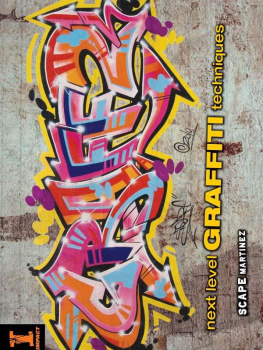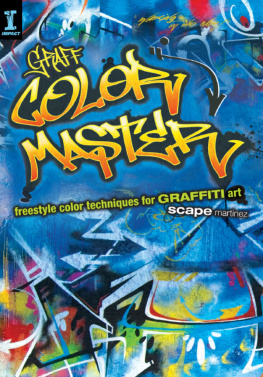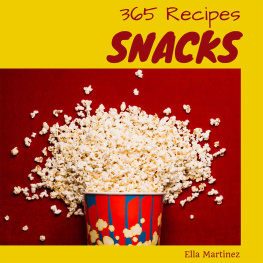For as long as I can remember, there was and still is only one way to get good at graffiti art and that is to practice. To practice and to copy. Many times, other older and more experienced graffiti writers would give me some of their sketches, and I would greedily go and copy, trace, and color them in. Over time the lines and shapes would sink into my brain, and Id have them memorized. I would remember where the arrows went or how to twist the letters just right. I would begin to understand color patterns and techniques and continue to practice.
This book is an extension of that rich tradition.
In this book youll find a collection of images. They were drawn by me with the intent to share them with you. Look at them, study them and flip them around. Copy, trace, and fill them in, be a part of the tradition. Soak up the styles and in time youll be able to create your own. If I can contribute anything to your progress its going to be some drawings that I am sharing, just like ancient cavemen. I encourage you to run with your imagination and take my outlines with you.
Some may yet wonder: does the world need a GRAFF Coloring book? Absolutely! A coloring book like this increases the democratic nature of the art form. For fans and practitioners alike, this is a platform for creativity. My hope is that this book will help users understand art concepts and graffiti art basics. This book will give you the opportunity to focus on your colors and their use and increase your creative expression potential. Mark a lot or a little, its all up to you!
So grab your crayons, colored pencils, markers, pens, and paints. And remember to think outside the box and color outside the lines!
Supplies to Get You Started
This coloring book is designed for you to use a variety of mediums, so expand your tool set. You can use any combination of the following:
Charcoal sticks
Colored Pencils
Crayons
Inks
Oil Pastels
Permanent art markers
Wax pencils
Color
Graffiti colors must come on strong and bold and with an edge. They must be a dominant element in the design. You should be familiar with the following main color terms.
Primary colors: red, blue and yellow.
Secondary colors: colors made by mixing primary colors to get orange, green and violet.
Tertiary colors: colors made by mixing a primary color with a secondary color sitting next to it on the color wheel.
Complementary colors: colors opposite one another on the color wheel.
Analogous colors: colors adjacent or close to each other on the color wheel.
When working with colors, articulate your personal style with the letter design and the color patterns. Color is the vital element of graffiti style; the energy comes from how colors interact. Start off making color choices that will energize and transform your work. Your color sensibilities and confidence in creating combinations will develop over time.
Colors and their interplay are catalysts for feelings and stimulation. So look at the color wheel and reflect a bit about what colors resonate with you before you begin. What types of colors are they? Are they primaries? And if so, can you work with their complements or analogous colors? An easy trick is to pick your favorite colors and then work with the analogous colors and tie them together with a tertiary color. Confused? Dont be.
With graffiti, color and color theory are based more on physical experiences and visceral choices than abstracted concepts. Graffiti art is based on practiceits experiential. So the color combinations can be playful, aggressive or even subliminal, but never predictable. See remember the focus, remember where we are going with this. Were here to create a personal, visual statement.
Color Wheel
Colors to Live By
The following are examples of color palettes in groups of five. Me, I am very influenced by the pinks, purples and blues. As a starting point, these tend to be my dominant colors. I go with their analogous colors for blending, and darker colors like deep burgundies, reds, ultramarine blue and greens as accents. For me, these have instant impact when paired together. And combinations like true blues paired with magentas and yellows pop and generate crazy energy for me.
Color Combinations
Kilroy Was Here
The term graffiti originally referred to the inscriptions and markings found on the walls of ancient ruins, such as in the civilizations of Greece and Rome. Graffiti was done by the ancient Egyptians, the Vikings and even the Mayans. These people communicated with each other about daily life, current events, etc., offering us a direct look into their ancient street life. It is a tradition of communication.
Even before this, there were caves in France where prehistoric man left markings on the walls to let us know who was there. And over the centuries, those caves evolved into the tunnels of the New York subway system, and today onto your computer desktop.
So you can go back in time and find that certain Renaissance artists explored the ideas of painting their names on monuments during the Napoleonic Wars in the early 1800s.
There are also many exampled of graffiti occurring in American history. It is part of our timeless quest for self-identity and self-affirmation.
From the womb to the tomb, we as human beings have had the need to create and mark our territory. We need to let the rest of the world know we are here. This is the true foundation for graff writing.
A BRIEF TIMELINE
Circa 13,500 B.C.
Cave Paintings of bison, deer and horses are created in Lascaux, France.
520 B.C.
Wall paintings are created in the Tomb of the Lionesses, Monterozzi necropolis, Tarquinia, Italy.
Circa A.D. 300
Wall paintings are created in the tomb of Takehara, Fukuoka, Japan, Kofun period.
Circa A.D. 661
Arabic calligraphy flourishes throughout the Middle East as a spiritual technique and soon is recognized as the supreme art form of the Islamic World.
Circa A.D. 776
Murals are painted in the Bonampak in the rainforests of Chiapas, Mexico.
1946
The legend Kilroy was here is reportedly solved, says the New York Times. The originator (or at least the one who claimed the prize, a trolley car) is named James J. Kilroy. He worked at a shipyard where he scrawled in white chalk on the ships. These found their way throughout Europe during World War II, and as American forces took back towns, soldiers wrote Kilroy was here on whatever wall was left standing. Later, Kilroy becomes synonymous with graffiti, finding its way onto countless notebook covers.












